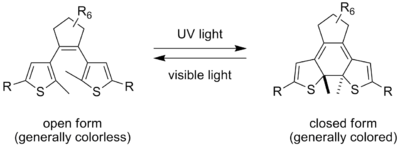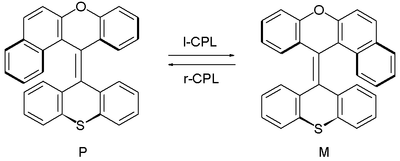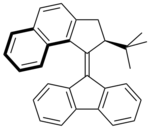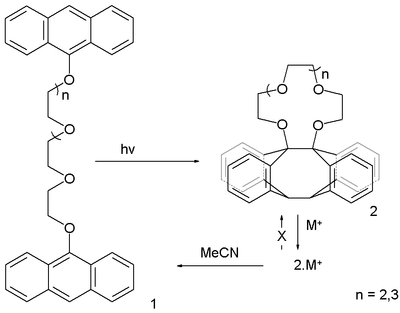- Molecular switch
-
A molecular switch is a molecule that can be reversibly shifted between two or more stable states.[1] The molecules may be shifted between the states in response to changes in e.g. pH, light, temperature, an electrical current, microenvironment, or the presence of a ligand. In some cases, a combination of stimuli are utilized. The oldest forms of synthetic molecular switches are pH indicators, which display distinct colors as a function of pH. Currently synthetic molecular switches are of interest in the field of nanotechnology for application in molecular computers. Molecular switches are also important to in biology because many biological functions are based on it, for instance allosteric regulation and vision. They are also one of the simplest examples of molecular machines.
Contents
Photochromic molecular switches
A widely studied class are photochromic compounds which are able to switch between electronic configurations when irradiated by light of a specific wavelength. Each state has a specific absorption maximum which can then be read out by UV-VIS spectroscopy. Members of this class include azobenzenes, diarylethenes, dithienylethenes, fulgides, stilbenes, spiropyrans and phenoxynaphthacene quinones.
Chiroptical molecular switches are a specific subgroup with photochemical switching taking place between an enantiomeric pairs. In these compounds the readout is by circular dichroism rather than by ordinary spectroscopy. Hindered alkenes such as the one depicted below change their helicity (see: planar chirality) as response to irradiation with right or left-handed circularly polarized light
Chiroptical molecular switches that show directional motion are considered synthetic molecular motors [2]:
Host-guest molecular switches
In host-guest chemistry the bistable states of molecular switches differ in their affinity for guests. Many early examples of such systems are based on crown ether chemistry. The first switchable host is described in 1978 by Desvergne & Bouas-Laurent [3][4] who create a crown ether via photochemical anthracene dimerization. Although not strictly speaking switchable the compound is able to take up cations after a photochemical trigger and exposure to acetonitrile gives back the open form.
In 1980 Yamashita et al. [5] construct a crown ether already incorporating the anthracene units (an anthracenophane) and also study ion uptake vs photochemistry.
Also in 1980 Shinkai throws out the anthracene unit as photoantenna in favor of an azobenzene moiety [6] and for the first time envisions the existence of molecules with an on-off switch. In this molecule light triggers a trans-cis isomerization of the azo group which results in ring expansion. Thus in the trans form the crown binds preferentially to ammonium, lithium and sodium ions while in the cis form the preference is for potassium and rubidium (both larger ions in same alkali metal group). In the dark the reverse isomerization takes place.
Shinkai employs this devices in actual ion transport mimicking the biochemical action of monensin and nigericin [7][8]: in a biphasic system ions are taken up triggered by light in one phase and deposited in the other phase in absence of light.
Mechanically-interlocked molecular switches
Some of the most advanced molecular switches are based on mechanically-interlocked molecular architectures where the bistable states differ in the position of the macrocycle. In 1991 Stoddart [9] devices a molecular shuttle based on a rotaxane on which a molecular bead is able to shuttle between two docking stations situated on a molecular thread. Stoddart predicts that when the stations are dissimilar with each of the stations addressed by a different external stimulus the shuttle becomes a molecular machine. In 1993 Stoddart is scooped by supramolecular chemistry pioneer Fritz Vögtle who actually delivers a switchable molecule based not on a rotaxane but on a related catenane [10][11]
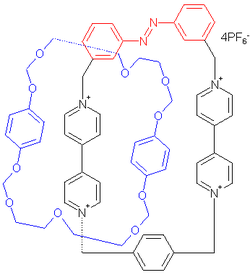
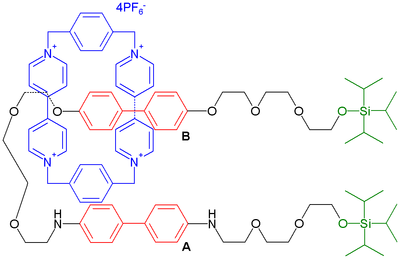
Photo switchable catenane Vögtle 1993 Molecular switch Kaifer and Stoddart 1994 This compound is based on two ring systems: one ring holds the photoswichable azobenzene ring and two paraquat docking stations and the other ring is a polyether with to arene rings with binding affinity for the paraquat units. In this system NMR spectroscopy shows that in the azo trans-form the polyether ring is free to rotate around its partner ring but then when a light trigger activates the cis azo form this rotation mode is stopped
Kaifer and Stoddart in 1994 modify their molecular shuttle [12] such a way that an electron-poor tetracationic cyclophane bead now has a choice between two docking stations: one biphenol and one benzidine unit. In solution at room temperature NMR spectroscopy reveals that the bead shuttles at a rate comparable to the NMR timescale, reducing the temperature to 229K resolves the signals with 84% of the population favoring the benzidine station. However on addition of trifluoroacetic acid, the benzidine nitrogen atoms are protonated and the bead is fixed permanently on the biphenol station. The same effect is obtained by electrochemical oxidation (forming the benzidine radical ion) and significantly both processes are reversible.
In 2007 molecular shuttles are utilized in an experimental DRAM circuit [13]. The device consists of 400 bottom silicon nanowire electrodes (16 nanometer (nm) wide at 33 nm intervals) crossed by another 400 titanium top-nanowires with similar dimensions sandwiching a monolayer of a bistable rotaxane depicted below:
Each bit in the device consists of a silicon and a titanium crossbar with around 100 rotaxane molecules filling in the space between them at perpendicular angles. The hydrophilic diethylene glycol stopper on the left (gray) is specifically designed to anchor to silicon wire (made hydrophilic by phosphorus doping) while the hydrophobic tetraarylmethane stopper on the right does the same to the likewise hydrophobic titanium wire. In the ground state of the switch, the paraquat ring is located around a tetrathiafulvalene unit (in red) but it moves to the dioxynaphthyl unit (in green) when the fulvalene unit is oxidized by application of a current. When the fulvalene is reduced back a metastable high conductance '1' state is formed which relaxes back to the ground state with a chemical half-life of around one hour. The problem of defects is circumvented by adopting a defect-tolerant architecture also found in the Teramac project. In this way a circuit is obtained consisting of 160,000 bits on an area the size of a white blood cell translating into 1011 bits per square centimeter.
References
- ^ Molecular Machines & Motors (Structure and Bonding) J.-P. Sauvage Ed. ISBN 3540413822
- ^ Chiroptical Molecular Switches Ben L. Feringa, Richard A. van Delden, Nagatoshi Koumura, and Edzard M. Geertsema Chem. Rev.; 2000; 100(5) pp 1789 - 1816; (Review) doi:10.1021/cr9900228
- ^ Cation complexing photochromic materials involving bisanthracenes linked by a polyether chain. Preparation of a crown-ether by photocycloisomerization Jean-Pierre Desvergne and Henri Bouas-Laurent J. Chem. Soc., Chem. Commun., 1978, 403 - 404, doi:10.1039/C39780000403
- ^ FROM ANTHRACENE PHOTODIMERIZATION TO JAW PHOTOCHROMIC MATERIALS AND PHOTOCROWNS Henri Bouas-Laurent, Alain Castellan and Jean-Pierre Desvergne Pure & Appl. Chem.5 Vol.52, pp.2633—2648. 1980 Link
- ^ Synthetic macrocyclic ligands. II. Synthesis of a photochromic crown ether Tetrahedron Letters, Volume 21, Issue 6, 1980, Pages 541-544 Isamu Yamashita, Mieko Fujii, Takahiro Kaneda, Soichi Misumi and Tetsuo Otsubo doi:10.1016/S0040-4039(01)85550-7
- ^ Photoresponsive crown ethers. 1. Cis-trans isomerism of azobenzene as a tool to enforce conformational changes of crown ethers and polymers Seiji Shinkai, Takahiro Nakaji, Yoshihiro Nishida, Toshiyuki Ogawa, and Osamu Manabe J. Am. Chem. Soc.; 1980; 102(18) pp 5860 - 5865; doi:10.1021/ja00538a026
- ^ Photoresponsive crown ethers. 2. Photocontrol of ion extraction and ion transport by a bis(crown ether) with a butterfly-like motion Seiji Shinkai, Takahiro Nakaji, Toshiyuki Ogawa, Kazuyoshi Shigematsu, and Osamu Manabe J. Am. Chem. Soc.; 1981; 103(1) pp 111 - 115; doi: 10.1021/ja00391a021
- ^ Switch-functionalized systems in biomimetic chemistry Seiji Shinkai Pure & App!. Chem., Vol. 59, No. 3, pp. 425-430, 1987 Link
- ^ A molecular shuttle Pier Lucio Anelli, Neil Spencer, and J. Fraser Stoddart J. Am. Chem. Soc.; 1991; 113(13) pp 5131 - 5133; doi:10.1021/ja00013a096
- ^ Photoswitchable Catenanes Fritz Vögtle, Walter Manfred Müller, Ute Müller, Martin Bauer, Kari Rissanen
- ^ Also in 1993: A Light-Induced Molecular Shuttle Based on a [2]Rotaxane-Derived Triad Angewandte Chemie International Edition in English Volume 32, Issue 10, Date: October 1993, Pages: 1459-1461 Andrew C. Benniston, Anthony Harriman doi:10.1002/anie.199314591
- ^ A chemically and electrochemically switchable molecular shuttle Richard A Bissell, Emilio Córdova, Angel E. Kaifer, J. Fraser Stoddart Nature 369, 133 - 137 (12 May 1994) Letter doi:10.1038/369133a0
- ^ A 160-kilobit molecular electronic memory patterned at 1011 bits per square centimetre Jonathan E. Green, Jang Wook Choi1, Akram Boukai, Yuri Bunimovich, Ezekiel Johnston-Halperin, Erica DeIonno, Yi Luo, Bonnie A. Sheriff, Ke Xu, Young Shik Shin, Hsian-Rong Tseng, J. Fraser Stoddart and James R. Heath Nature 445, 414-417 (25 January 2007) | doi:10.1038/nature05462
Categories:- Supramolecular chemistry
- Molecular machines
Wikimedia Foundation. 2010.

